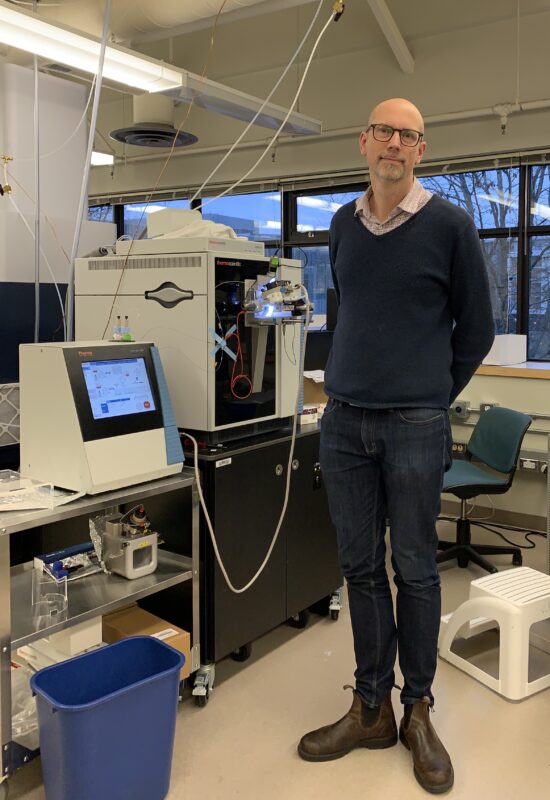Newsroom
Interdisciplinary thinking in the life sciences: a conversation with Dr. Thibault Mayor
Writing and photography by Fangwu Wang from the Hirst Lab, Michael Smith Laboratories
Reflecting on the history of the Nobel Prize, many of the most impactful discoveries in the life sciences originated from other disciplines. For instance, two-time Chemistry laureate Frederick Sanger made transformative discoveries related to insulin protein structure and DNA sequencing. Similarly, the invention of magnetic resonance imaging (MRI) by Paul C. Lauterbur and Sir Peter Mansfield, awarded the 2003 Nobel Prize in Physiology or Medicine, revolutionized diagnostic medicine. Our own founding Director, Dr. Michael Smith, was honored with the 1993 Nobel Prize in Chemistry for the invention of site-directed mutagenesis, a critical advancement in genetic research.
While research within a single discipline often follows a linear path of progressive, incremental discoveries, interdisciplinary research feels more like traversing between paths, advancing multiple dimensions in parallel. Each discipline has established foundational truths, and understanding these core principles is vital for making progress within any field. However, approaching research in an interdisciplinary fashion is more than merely combining knowledge from various areas. It requires integrating diverse ways of understanding and connecting them in meaningful ways—a practice that transforms thinking into truly interdisciplinary exploration.

Interdisciplinary thinking – bridging different paths in the life sciences
Interdisciplinary research is becoming increasingly central—and even urgent—in today’s scientific landscape, due to the rapid accumulation and maturation of knowledge within each discipline. Integrating insights across fields not only opens new avenues of investigation, but is also essential for tackling complex challenges like understanding and treating human diseases.
Guided by the vision of fostering an interdisciplinary research environment, the Michael Smith Laboratories was established and continues to thrive as a collaborative community of scientists from diverse disciplinary backgrounds.
To gain insights into interdisciplinary thinking in life science research, we spoke with Dr. Thibault Mayor, a professor in the Michael Smith Laboratories (MSL) and the Department of Biochemistry and Molecular Biology (BMB) at UBC. Dr. Mayor’s research program employs interdisciplinary approaches to address protein homeostasis with a link to aging and neurodegenerative diseases. His work integrates many subdisciplines and approaches to understand how misfolded proteins are managed within cells, aiming to reveal the underlying mechanisms that can inform treatments for conditions like Parkinson’s and Alzheimer’s disease.

Dr. Thibault Mayor with the Mass Spectrometer Orbitrap Exploris 480 in the MSL Proteomics Core Facility
What are the keywords in your research?
My research spans biochemistry, cell biology, yeast genetics, synthetic biology, proteomics and computational science.
How has your training and experience led you to develop expertise in these different disciplines?
I often found myself working on topics I wasn’t initially interested in. I started with a strong interest in environmental sciences and ecology during my undergrad, focusing mainly on macroscopic systems for the first two years. Then I took a molecular biology course and got hooked on the complexity of cell signaling pathways, cell cycle and regulation of protein activities. Around that time, systems biology was an emerging field with the development of microarrays in the late 1990s, which inspired me to shift my focus to molecular biology and study life on a microscopic scale.
During my postdoc, I worked on the ubiquitin proteasome system, though initially I didn’t find this exciting at all. However, I later found the work on the ubiquitin pathways studied by a neighboring lab really intriguing. Similarly, I first thought that protein folding was somewhat boring, but as we started to look more closely at protein quality control mechanisms I got really excited by it.
Was integrating different disciplines into your research intentional, or did it develop naturally?
It developed naturally. When I faced challenges that required skills beyond my expertise, I learned new ones or collaborated with others. For example, as I decided to explore proteomics, which generates massive amounts of protein data, I realized I needed to collaborate with computational biologists to move forward. I now often work with Jörg Gsponer (MSL, BMB), an expert in computational science, to help with the analysis of our proteomic data.
New technologies constantly emerge, and they open up new ways to explore and discover new things, which keeps me motivated to integrate them into my research.
You mentioned collaboration. How do you approach building collaborations with researchers in different fields to achieve common goals?
I enjoy attending different kinds of conferences—some focused, others broader, like the American Society for Cell Biology meetings. Random encounters with unfamiliar studies often inspire new ideas. When something catches my interest, I reach out and start conversations with other researchers that can lead to collaborations. Being proactive is the key to creating opportunities.
Within UBC, collaboration is relatively easy and there are lots of great opportunities. Labs use distinct techniques and people are very friendly and open to working together.
Do you think there are particular challenges in interdisciplinary research in grant and publication review?
Interdisciplinary work often requires expertise in multiple areas, so journals need to involve reviewers who understand these diverse methods. For example, controls and parameters vary between proteomics, structural biology, and genetics, and reviewers must evaluate these rigorously.
For grant applications, you need to elaborate on a wide range of techniques within a proposal. It requires skill to demonstrate your grasp in those areas with just enough details to fit in the tight page numbers. Prior publications in relevant fields are helpful to show you know what you’re doing.
Interdisciplinary research involves navigating new paths. Do you see these gaps as challenges or opportunities?
Challenges create opportunities. They drive us to improve, innovate and collaborate. They push us to develop new technologies and move the field forward.
How do you make your research stand out in the field of protein homeostasis?
What distinguishes our studies is our integration of proteomics technologies. We design innovative proteomic approaches to tackle fundamental questions in protein quality control, such as how quickly proteins fold into their normal 3D structures in the cell and how misfolded proteins are recognized. These methods allow us to systematically study large groups of proteins and look at the system more globally.
For example, in our recent PNAS paper (Molzahn et al.), we discovered that during aging a subset of proteins are increasingly insoluble. Contrary to the common belief, it’s not the quantity but the composition of proteins in aggregates that changes with aging. We think it has important implications about how protein aggregation actually begins when cells are no longer capable of maintaining protein homeostasis.
What do you see as the future frontiers in this field?
Firstly, we need to focus on biological systems that are more relevant to human tissues. Currently, we rely heavily on tissue culture cell lines because they are easier to handle. However, cultured cells divide rapidly and have a high protein turnover rate, which doesn’t reflect the conditions in human tissues. Bridging the gap between these cell line models and the normal processes in human tissues is essential.
Another frontier is manipulating the protein homeostasis system—figuring out how to reverse changes associated with aging and disease. Bridging the microscopic and macroscopic scales is important to elucidate these mechanisms in complex organisms like humans.
Can you provide some advice to trainees who wish to build expertise in different disciplines and develop an interdisciplinary mindset?
- Work in different labs and learn diverse techniques. You can stay focused on the same question but approach it from multiple angles.
- Keep an open mind. I thought the ubiquitin proteasome system and chaperones were boring at first, but I ended up fascinated by them.
- Go to a variety of seminars—even if the topic seems unrelated. You might discover new techniques or ideas that complement your own research.
- Combine different methods for powerful results. Great papers often integrate multiple approaches, like structural biology and functional studies on cells and whole organisms.
What motivates you the most through your work?
Curiosity. I love answering fundamental questions about how things work—from single cells to entire systems in the body. New technologies allow us to ask new questions, and that’s what keeps me excited.
Quick links:
- Read the Mayor Lab’s recently published paper on proteomic changes in the aged mouse brain
- Learn more about the Mayor Lab